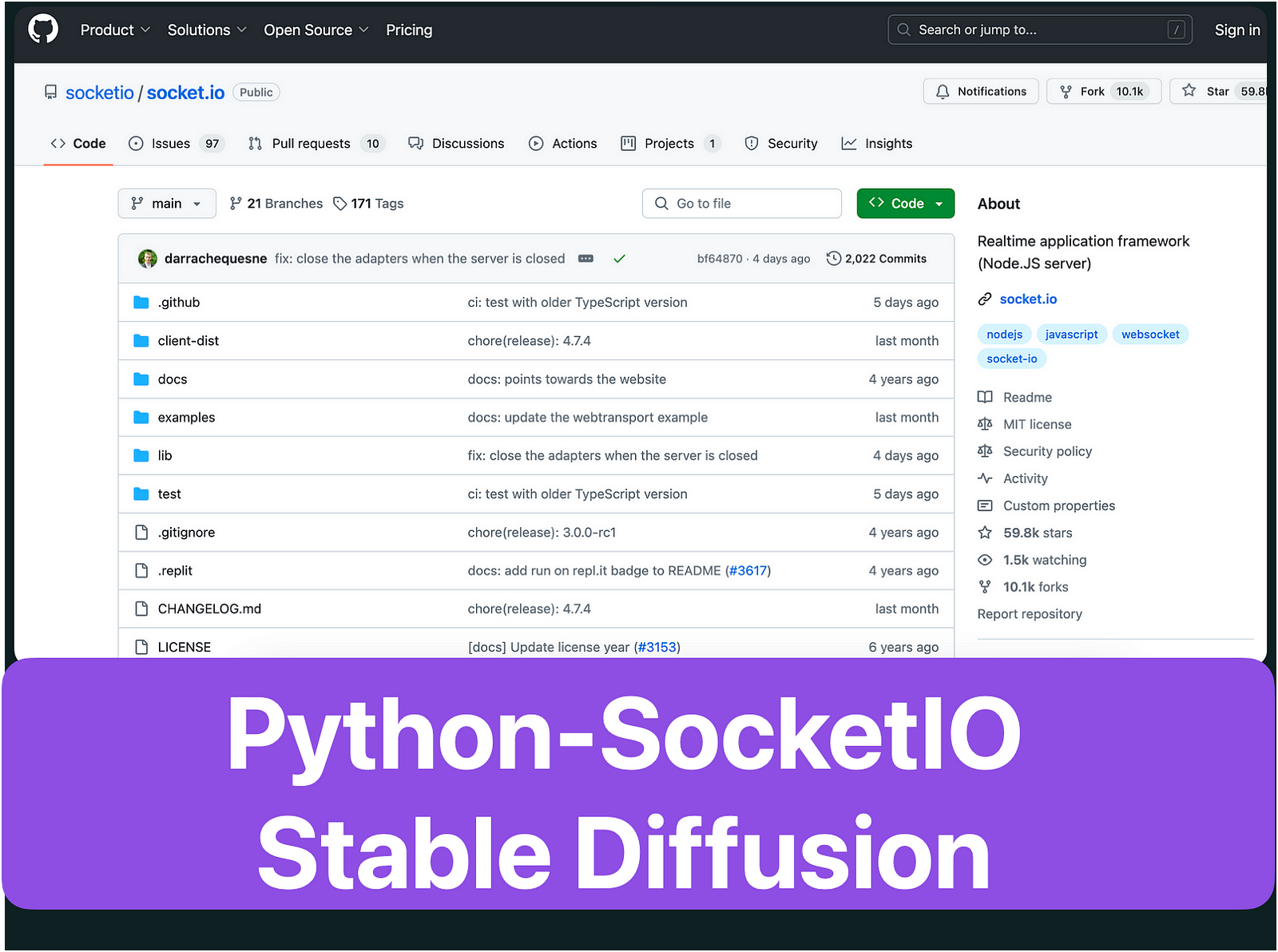How to Install Python-SocketIO on Stable Diffusion

Learn how to install Python-SocketIO on Stable Diffusion with our comprehensive guide. Explore the process in our latest blog post.
Introduction
In today’s digital age, stable data transfer is crucial for the smooth functioning of various systems and applications. Whether it’s real-time communication, artificial intelligence, or advanced features, the need for stable diffusion has become increasingly important. One of the popular tools used for stable data transfer is Python-SocketIO, a python library that facilitates real-time communication between the server and the client. In this blog, we will explore the relationship between Python-SocketIO and Stable Diffusion, understand their key features, and provide a detailed guide on how to install Python-SocketIO on Stable Diffusion. So, let’s dive in and explore the world of stable diffusion and python socket communication.
Understanding Stable Diffusion
Stable Diffusion is an AI model that generates images based on text prompts. Unlike traditional approaches that work directly with high-dimensional image data, Stable Diffusion compresses the image into a latent space. This latent space representation allows for efficient processing and manipulation of the image, enabling the model to generate high-quality images based on textual input.
Origin and Purpose of Stable Diffusion
Stable Diffusion employs an iterative method, gradually diffusing the image from the initial state to the target state, resulting in high-quality image generation outcomes. Python-SocketIO can be integrated with various applications, including those for image generation. However, it does not directly interact with or influence Stable Diffusion technology.

Key Features of Stable Diffusion
Stable Diffusion, developed by OpenAI, is an advanced generative model that introduces several key features to improve the quality and control of image generation. Some of the key features of Stable Diffusion include:
- Diffusion Process: Stable Diffusion employs a diffusion process, where an image is iteratively transformed from a noisy initial state to a desired target state. This process allows for the generation of high-quality images by gradually refining the initial noise.
- Guided Diffusion: Stable Diffusion incorporates a guidance mechanism that influences the diffusion process. This guidance can be provided through a variety of inputs, such as textual prompts or reference images, to control the output image generation.
- Adaptive Step Size: Stable Diffusion utilizes an adaptive step size during the diffusion process. This means that the model can dynamically adjust the magnitude of changes made at each iteration, leading to improved stability and control over the generation process.
- Progressive Training: The model is trained progressively, starting from low-resolution images and gradually increasing the resolution over time. This progressive training approach helps in generating detailed and high-resolution images.
- Diversity-Promoting Techniques: Stable Diffusion employs techniques to encourage the generation of diverse images. By adjusting certain parameters, such as the diffusion time or temperature, the model can produce variations of the same image, allowing for exploration of different creative possibilities.
- Fine-Tuning and Interpolation: Stable Diffusion supports fine-tuning of generated images. Users can refine or modify the generated outputs by providing additional guidance or constraints. Additionally, interpolation between different guidance inputs is possible, allowing for smooth transitions between different visual attributes.
These key features collectively contribute to enhancing the quality, control, and diversity of image generation in Stable Diffusion.
AUTOMATIC1111/stable-diffusion-webui

Exploring Python-SocketIO
Python-SocketIO is a widely used python library that enables socket communication between the server and the client. It provides a stable environment for real-time communication, allowing data to be transmitted instantaneously between different components of a system. Python-SocketIO utilizes websockets for data transfer, ensuring seamless communication and enabling bidirectional data flow. One of the key features of Python-SocketIO is its ability to create namespaces, which helps in establishing distinct communication channels, thereby improving data transfer efficiency. With its stable diffusion capabilities, Python-SocketIO has become a preferred choice for socket communication in various applications and systems.
What is Python-SocketIO?
Python-SocketIO is a Python library that facilitates real-time socket communication between the server and the client. It provides a stable environment for data transfer, ensuring seamless and reliable communication between different components of a system. The library uses web sockets to establish the connection between the server and the client, allowing for efficient and bidirectional data transfer. One of the key features of Python-SocketIO is its support for namespaces, which enables the creation of distinct communication channels within a single server. This feature enhances the organization and management of socket connections, improving data transfer efficiency and overall performance.
- a Node.js server: Source | API
- a Javascript client library for the browser (which can be also run from Node.js): Source | API

Why Choose Python-SocketIO?
Python-SocketIO is a popular library for real-time communication, and there are several reasons why you might choose to use it for your needs:
- Ease of Use: Python-SocketIO simplifies working with WebSockets, abstracting away complexities and providing a straightforward interface. This makes it accessible to developers with varying levels of experience.
- Cross-Browser and Cross-Platform Compatibility: Python-SocketIO ensures compatibility across different browsers and platforms. This flexibility allows your application to reach a wider audience and ensures consistent communication regardless of the user’s device or browser choice.
- Scalability: Python-SocketIO is designed to be scalable, making it suitable for both small-scale applications and large-scale systems. It can handle a high volume of concurrent connections efficiently, enabling your real-time communication to scale as your needs grow.
- Bi-Directional Communication: Python-SocketIO supports bidirectional communication, enabling the server and client to exchange messages without the need for continuous polling. This efficient and responsive communication approach enhances the real-time experience for your users.
- Event-Driven Architecture: Python-SocketIO follows an event-driven architecture, allowing you to easily handle different types of messages and events in your application. This makes it convenient to trigger actions or respond to specific events that occur during the real-time communication process.
Considering these benefits, Python-SocketIO is well-suited for integrating real-time communication capabilities into applications, including use cases such as Stable Diffusion. It provides a reliable and flexible foundation for building interactive and responsive systems.

The Relationship Between Python-SocketIO and Stable Diffusion
Python-SocketIO and stable diffusion have a close relationship when it comes to data transfer. Python-SocketIO, being a python library, can be used within the stable diffusion environment to enhance data transfer capabilities. Python-SocketIO provides stable diffusion of data, ensuring reliable and efficient socket communication between different components of a system. By utilizing the features of Python-SocketIO, stable diffusion can leverage advanced data transfer techniques, enhancing the overall performance and reliability of data transfer processes. The combination of Python-SocketIO and stable diffusion enables stable and secure transfer of data, making it a powerful tool for various applications and systems.
How Python-SocketIO Enhances Stable Diffusion
Python-SocketIO plays a crucial role in enhancing the performance of stable diffusion. By providing stable data transfer capabilities, Python-SocketIO ensures that data is transmitted accurately and efficiently, improving overall system performance. With its support for real-time communication, Python-SocketIO enables prompt and immediate transfer of data, ensuring that the system remains responsive and up to date. By integrating Python-SocketIO into stable diffusion, developers can optimize data transfer processes, improving the efficiency and reliability of data transfer between different components of the system. This enhances the overall stability of stable diffusion, enabling seamless communication and reliable data transfer in various applications and systems.
Real-world Applications of Python-SocketIO in Stable Diffusion
Python-SocketIO finds extensive use in real-world applications where stable diffusion is of utmost importance. Some of the notable applications include:
- Chat server systems that require stable and reliable communication between multiple clients.
- Diffusion of real-time data in artificial intelligence applications, ensuring prompt updates and accurate data transfer.
- Integration with web UI development, enabling stable socket communication in web-based user interfaces.
- Collaborative applications that require stable data transfer between multiple users, ensure efficient and real-time interaction.
- Web-based games where stable diffusion of data is essential for seamless gameplay and bidirectional communication.
- These are just a few examples of how Python-SocketIO, in conjunction with stable diffusion, enhances data transfer capabilities in various real-world applications.

Pre-requisites for Installing Python-SocketIO on Stable Diffusion
Before installing Python-SocketIO on stable diffusion, there are a few pre-requisites that need to be met. These include:
- Ensuring compatibility of the operating system with stable diffusion and Python-SocketIO.
- Checking for the latest version of Python installed in the system, as Python-SocketIO requires a certain version to function properly.
- Verifying the presence of any dependencies that Python-SocketIO relies on, such as additional Python packages or libraries.
- Having an active internet connection for downloading and installing the required software components.
- Ensuring that the web browser used supports webui features, if webui development is part of the installation process.
- By meeting these pre-requisites, developers can ensure a smooth and successful installation of Python-SocketIO on stable diffusion.
Required Hardware and Software
To install Python-SocketIO on stable diffusion, certain hardware and software requirements must be met. These include:
As the Python SocketIO client is a Python library, you must install Python; Otherwise, it will not work. For Installing Python, Click Here. This will download the setup file. Now open the setup and install the Python in the same way you install any software or game.
- Compatibility of the operating system with stable diffusion and Python-SocketIO. Different operating systems may have specific system requirements that need to be fulfilled.
- Sufficient hardware resources, such as CPU, RAM, and storage, to support stable diffusion and Python-SocketIO.
- The latest version of Python is installed in the system, ensuring compatibility with Python-SocketIO.
- Software dependencies, such as python packages or libraries, required for the proper functioning of Python-SocketIO.
- An active internet connection to download and install the necessary software components.
- A web browser that supports webui features, if webui development is part of the installation process.
- By ensuring compatibility and fulfilling the hardware and software requirements, developers can set up a stable diffusion environment and install Python-SocketIO successfully.
Setting up the Environment
To install Python-SocketIO on stable diffusion, it is essential to set up the environment correctly. The following steps can guide developers through the process:
To create a virtual environment for Python to use SocketIO, you can follow these steps:
- Press Window + R and type CMD.
- Copy the following command and paste it into the cmd.
python3 -m venv Env_Name
you can replace “Env_Name” with any name you prefer. Here’s an example:
python3 -m venv MyEnv
To activate the virtual environment you created, you can copy the code and paste it into the cmd.
Env_Name\Scripts\activate
A Detailed Guide to Installing Python-SocketIO on Stable Diffusion
Now, let’s dive into the installation process of Python-SocketIO on stable diffusion. Here is a step-by-step guide to help you get started:
Step 1: Downloading and Install Python
socketio/socket.io Realtime application framework (Node.JS server)
There are also several client implementations in other languages, which are maintained by the community:
- Java: https://github.com/socketio/socket.io-client-java
- C++: https://github.com/socketio/socket.io-client-cpp
- Swift: https://github.com/socketio/socket.io-client-swift
- Dart: https://github.com/rikulo/socket.io-client-dart
- Python: https://github.com/miguelgrinberg/python-socketio
- Net: https://github.com/Quobject/SocketIoClientDotNet
To utilize Python-SocketIO for your client-side requirements, you need to install the library first. To install Python-SocketIO, simply copy the provided code snippet and paste it into the cmd. This command will initiate the installation process. Once the installation is complete, you will be equipped with the necessary tools to proceed with your client-side setup using Python-SocketIO.
pip install python-socketio[client]
Step 2: Setting up Stable Diffusion
- Next, you need to set up stable diffusion, which can be downloaded from the official stable diffusion GitHub repository.
- Download the stable diffusion zip file and extract its contents to a location of your choice on your system.
- Review the documentation provided with stable diffusion to understand the features and functionalities it offers.
- Ensure compatibility of stable diffusion with your operating system, making any necessary modifications or adjustments to the settings.
- You are now ready to proceed to the next step of installing Python-SocketIO into stable diffusion.

Step 3: Installing Python-SocketIO into Stable Diffusion
- Once the installation is complete, verify the successful installation by running a simple socketio code snippet, confirming that Python-SocketIO is functioning correctly within the stable diffusion environment.
- Congratulations! You have successfully installed Python-SocketIO on stable diffusion, setting the stage for stable socket communication in your system.
Verifying and Troubleshooting the Installation
After the installation of Python-SocketIO on stable diffusion, it is crucial to verify its functionality and address any potential issues. Here are some steps to help you confirm the successful installation and troubleshoot any problems that may arise:
How to Confirm Successful Installation
- Test Python-SocketIO’s functionality by running the sample socket io code provided in the documentation.
npm test
This runs the gulp task test. By default the test will be run with the source code in lib directory.
Set the environmental variable TEST_VERSION to compat to test the transpiled es5-compat version of the code.
The gulp task test will always transpile the source code into es5 and export to dist first before running the test.
- Verify the data transfer between the client and server using socketio, ensuring bidirectional communication is working as expected.
- Check the webui visual interface, if applicable, for any errors or inconsistencies that may indicate an issue with the installation.
- Confirm the stability of the server by transferring artificial intelligence data, ensuring stable diffusion of data without any loss or corruption.
- By following these steps, you can confirm the successful installation of Python-SocketIO on stable diffusion and ensure that it is functioning optimally.
Start Generating Images
After setting up Stable Diffusion as the server and Python-SocketIO as the client, you can now utilize Python-SocketIO with Stable Diffusion to generate images. To initiate image generation, you need to send requests in JSON format. Here is an example of how to structure your JSON requests:
{
"prompt": "A boy flying kite"
}

Optimizing Your Use of Python-SocketIO on Stable Diffusion
To make the most of Python-SocketIO on stable diffusion, certain best practices and optimization techniques can be employed. These include:
Best Practices for Maximizing Performance
- Implement advanced features provided by Python-SocketIO to enhance data transfer performance and user experience. For example, utilize namespaces to manage socket connections efficiently.
- Optimize code for stable diffusion, ensuring compatibility across different operating systems and Python environments.
- Keep up with the latest version of the Python package manager and update dependencies regularly to take advantage of performance improvements.
- Utilize server-side features offered by Python-SocketIO to optimize server performance, enhancing the overall stability of stable diffusion.
- By following these best practices, developers can maximize the performance and user experience of Python-SocketIO on stable diffusion, ensuring stable and efficient data transfer in their applications.
Case Studies of Python-SocketIO on Stable Diffusion
To showcase the real-world applications of Python-SocketIO on stable diffusion, let’s explore a few case studies and success stories:
Success Stories Using Python-SocketIO on Stable Diffusion
- Chatgpt, an artificial intelligence-powered chatbot, leverages Python-SocketIO on stable diffusion for stable and reliable communication between users and the chat server.
- AI applications, such as data processing and analysis, utilize Python-SocketIO on stable diffusion to ensure prompt updates and accurate data transfer, enhancing the overall performance of artificial intelligence systems.
- Several web-based applications, ranging from collaborative tools to live streaming platforms, use Python-SocketIO on stable diffusion to enable stable data transfer, enhancing user interaction and experience.
- These success stories demonstrate the diverse range of applications where Python-SocketIO, in conjunction with stable diffusion, has proven to be an effective solution for stable and efficient socket communication.
Conclusion
To sum up, Python-SocketIO is a powerful tool that enhances the capabilities of Stable Diffusion and opens up a world of possibilities for real-time communication and data exchange. By following the detailed installation guide and optimizing your use of Python-SocketIO, you can leverage its benefits to the fullest. From maximizing performance to troubleshooting common issues, this combination is a game-changer for developers and businesses alike. Furthermore, the success stories of Python-SocketIO on Stable Diffusion serve as proof of its effectiveness in various industries. So, if you haven’t already, it’s time to explore the potential of Python-SocketIO on Stable Diffusion and take your applications to the next level. Happy coding!
novita.ai provides Stable Diffusion API and hundreds of fast and cheapest AI image generation APIs for 10,000 models.🎯 Fastest generation in just 2s, Pay-As-You-Go, a minimum of $0.0015 for each standard image, you can add your own models and avoid GPU maintenance. Free to share open-source extensions.
Recommended Reading

